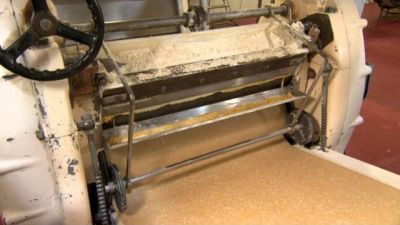
How It's Made Season 13 Episode 9 Thinning Shears; Wagon Wheels; Toaster Pastries; and Violin Bows
- 22 min
-
(9)
How It's Made season 13 episode 9 explores the manufacturing process behind four everyday items: thinning shears, wagon wheels, toaster pastries, and violin bows.
The episode begins with a look at the creation of thinning shears. These specialized scissors are used in the beauty industry for thinning out hair to create a more even cut. The process starts with forging the blades from high-quality stainless steel. The blades are then ground to a sharp edge and polished. Next, the handles are attached, often made from high-quality plastics or sleek metals. Once complete, each pair of shears is tested for quality and durability.
After exploring the production of thinning shears, the show transitions to wagon wheels. The manufacturing process for wagon wheels is a lengthy one that requires skilled craftsmen. It all begins with selecting the right type of wood, often Hickory, which is known for its strength and durability. The wood is turned into a wheel and then shaped into the correct size. The spokes and hub are then added before the wheel is drilled for the axle. Finally, the wheel is sanded and finished to provide it with a smooth and polished surface that is both functional and visually appealing.
Next up, the episode delves into the creation of toaster pastries. These convenient breakfast items have become a staple in many households. The process starts with mixing and baking the pastry crust. The fillings are then added, which can include a range of flavors from fruit to chocolate. The pastries are then formed into their characteristic shape, which may include a variety of designs. The final step is packaging the toaster pastries for shipping to homes across the country.
Finally, the episode wraps up with a look at the intricate process behind the creation of violin bows. These important components of a violin are responsible for producing the instrument's sound. The creation of a bow starts with selecting raw materials, typically Pernambuco wood from Brazil. The wood is then cut and shaped to the proper size and the bow's fittings are added. The frog, which is the part of the bow that the player holds, is made from materials such as ebony or ivory. The bow is then strung with horsehair, which is carefully selected and processed to ensure that it is strong and flexible. The end result is a beautiful and functional violin bow that is essential for producing the exquisite sound of a violin.
Overall, this episode of How It's Made provides a fascinating look at the intricate manufacturing processes behind four common items. From the artistry involved in creating a violin bow to the precision needed to make a pair of thinning shears, viewers are treated to an inside look at the skilled craftsmanship that goes into these everyday objects.
